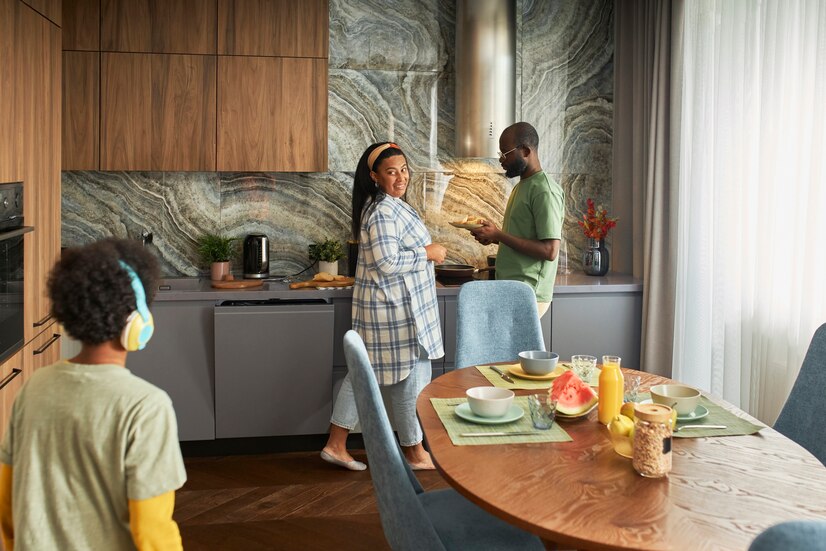Home Improvement
Common Household Plumbing Problems and How to Address Them

Maintaining a home requires vigilance and an understanding of its various systems, with plumbing being one of the critical components of any residence. Common Household problems can seriously compromise the integrity and functionality of your living space at any time, but you can avoid them by learning how to deal with them skillfully. As detracting as they may be, these problems can often be a chance to exercise proactive maintenance, saving you from the distress of unexpected repairs and costs.
When facing intricate plumbing difficulties, accessing seasoned professionals, such as those at Drain Solvers Longmont Plumbers, can provide peace of mind and ensure that solutions are practical and enduring. Yet, many situations are manageable only after immediately seeking expert assistance if you have the proper knowledge and tools.
Understanding Plumbing Systems
A home’s plumbing system is complex and multifaceted. It consists of two main parts: the drainage system, which removes waste, and the water supply system, which supplies fresh water. Knowing the layout of your system, including where shut-off valves are and how pipes are routed, can make troubleshooting more manageable when issues arise. Performing routine inspections for leaks, pipe damage, or irregular water pressure can avert potential crises and extend the system’s longevity.
Dripping Faucets
It’s a scenario many are familiar with the relentless dripping of a faucet that not only disrupts the quiet of a home but also contributes to water waste and increased utility bills. Often, this issue is caused by worn-out O-rings or washers, which can be replaced with an elemental DIY spirit and a willingness to tackle the problem hands-on. However, if the dripping persists after a fresh installation of parts, it could indicate a more severe issue within the faucet mechanism or the pipes themselves – a sign it’s time to call the professionals.
Clogged Drains
Clogged drains are a common and aggravating problem in many households, manifesting in backed-up sinks and slow-draining bathtubs. The usual suspects are accumulations of hair, grease, and other debris that bind over time. While chemical cleaners offer a quick fix, they can also contribute to pipe degradation. Physical tools such as plungers and plumber’s snakes present a safer and more sustainable solution. The step-by-step guidance on proper techniques for clearing drains can empower homeowners to resolve the issue themselves, reserving professional help for more persistent clogs.
Running Toilets
Running toilets are one of the most common household plumbing issues, often leading to unnecessarily high water bills if not dealt with promptly. Internal components such as the flapper valve, toilet float, or fill tube generally cause this continuous water flow. Thankfully, these parts are relatively inexpensive and straightforward to replace. Trouble begins when the issue lies deeper within the toilet’s plumbing or if replacing parts becomes routine—signs of other underlying problems that typically fall outside the bounds of DIY fixes.
Leaky Pipes
From subtle drips to catastrophic bursts, leaky pipes can cause incredible damage to a home’s structure if left unrepaired. Identifying leaks can be as simple as looking for water stains on ceilings or feeling for moisture under sinks. Temporary fixes can hold back the tide until professional help is available. Nevertheless, skilled plumbers should be consulted for a permanent, reliable repair. Their expertise can remedy the immediate problem and help homeowners avoid future occurrences through proactive measures.
Low Water Pressure
Low water pressure affects everything from showering to the efficiency of washing appliances, and it can indicate broader plumbing concerns. Causes include faucet sediment build-up and more severe issues such as corroded piping. Homeowners can resolve fundamental problems by cleaning aerators or inspecting individual fixtures. However, suppose the issue is systemic within the home, or no obvious cause is apparent. In that case, it is advisable to seek insight on improving water pressure and, possibly, enlist the services of a professional to diagnose and rectify the root cause.
Faulty Water Heaters
A malfunctioning water heater can upend the comfort of domestic life, presenting homeowners with icy showers and disrupted routines. Common issues such as sediment accumulation, a faulty heating element, or a misadjusted thermostat can often be the source of failure. Regular checks, flushing of the tank, and inspections of the heater’s components can go a long way in extending its lifespan. However, when a water heater reaches the end of its serviceable life or encounters issues beyond simple adjustments, a trained plumber’s evaluation and intervention are necessary to maintain safety and restore function.
Sewer System Backup
The dread that accompanies the realization of a sewer system backup is unparalleled. Such backups can create unsanitary conditions and extensive damage. Recognizing the warning signs, such as multiple drain clogs, gurgling toilets, and water pooling around basement floor drains, is crucial to addressing the problem early and avoiding disaster. The best defense against sewer backups is prevention—regular inspections and being mindful of what goes down the drains play a critical role.
Frozen Pipes
The plummeting temperatures of winter can lead to frozen pipes, which pose a severe risk to a home’s integrity. Insufficient insulation, especially in unheated areas of a house, increases the vulnerability of pipes to freeze. Vigilantly keeping the home warm and pipes insulated is a first line of defense, along with letting faucets drip during extreme cold to prevent pressure build-up. If pipes do freeze, gradual thawing with a hairdryer or heating pad can help avert bursting, though caution is advised to avoid heat sources that could start a fire or cause pipe damage.
Jammed Garbage Disposal
Jammed garbage disposals can halt kitchen activities and often result from misuse or overloading. To preserve this appliance, avoid disposing of complex food wastes such as bones, fibrous materials like cornhusks, and cooking oils that can solidify. If a jam occurs, one can attempt to reset the unit or manually turn the blades using an Allen wrench. However, persistent issues or unfamiliarity with the system may call for professional assistance to prevent damage to the disposal or injury.
Silent Pipe Leaks
Silent pipe leaks often go unnoticed until they’ve done significant structural damage, leading to mold, rot, and costly repairs. Regularly monitoring your water bill for unexplainable increases can be a good indicator of a hidden leak. Listening to running water when no fixtures are in use and inspecting for wet spots on floors and walls can help detect leaks. Homeowners can often address visible leaks through DIY fixes, but for those elusive ones, employing modern leak detection technologies and the expertise of seasoned plumbers can be indispensable.
In summary, taking a proactive and knowledgeable approach to resolving common home plumbing problems can result in prompt interventions, preventing minor annoyances from becoming more extensive repairs. While many issues can be handled independently with the guidance of resources or information on improving water pressure, it’s also important to recognize when the situation calls for the expertise of seasoned professionals. An optimal blend of homeowner diligence and professional input ensures the enduring functionality and safety of your home’s plumbing system.
Home Improvement
Sustainable Solutions for Garden Irrigation: How to Keep Your Garden Thriving

Key Takeaways:
- Understand sustainable irrigation practices to conserve water and enhance garden health.
- Learn about modern irrigation technologies that benefit both the environment and your garden.
- Discover easy-to-implement strategies for maintaining efficient water usage.
Introduction to Sustainable Garden Irrigation
The term “sustainability” has gained significant traction recently, becoming a cornerstone of modern gardening practices. As gardeners and enthusiasts become more conscious of their environmental footprint, there’s a marked shift towards methods that conserve resources while promoting plant health. At the heart of this sustainable push is irrigation—a fundamental gardening aspect affecting plant growth and vitality. Even the most carefully tended gardens can suffer from inconsistent growth or plant loss without efficient irrigation.
Whether you’re experiencing plant health issues or simply seeking to modernize your current systems, exploring irrigation repair solutions might be your first step toward achieving a thriving garden. Sustainable irrigation practices go beyond merely conserving water. It’s about ensuring that every drop contributes effectively to your garden’s vitality, allowing plants to flourish while reducing waste. By integrating sustainable irrigation, you can enhance your garden’s beauty and establish an eco-friendly and economically viable system that respects our planet’s resources.
Types of Sustainable Irrigation Solutions
A spectrum of sustainable irrigation solutions is available, each catering to different needs and garden configurations. Among the most efficient is drip irrigation. This method delivers water directly to plant roots, significantly reducing wastage. Since the water is not sprayed over a wide area, evaporation and runoff are minimized. This method ensures that plants get the necessary hydration without water stress. Proper irrigation installation is key to maximizing these benefits, ensuring an efficient system that conserves water while promoting healthy plant growth.
Soaker hoses provide a viable alternative in areas where drip irrigation isn’t suitable. These hoses allow water to seep out slowly along the length of the hose, making them ideal for uniformly watering entire rows of plants or extensive garden beds. When implemented properly, soaker hoses can significantly reduce water use while maintaining consistent moisture levels. Additionally, rainwater harvesting systems can be a game-changer for sustainable irrigation. By collecting rainwater, these systems provide a natural, cost-effective water source, decreasing reliance on municipal water supplies and further integrating sustainable practices into everyday gardening.
Benefits of Sustainable Irrigation Practices
Adopting sustainable irrigation practices brings many benefits that extend beyond the garden. Environmentally, they represent a proactive step towards conserving water—a finite resource threatened by climate change and increasing global demand. These systems curtail water wastage and reduce runoff, diminishing the ecological impact on local water tables and aquatic ecosystems.
Eco-conscious gardening doesn’t stop at environmental benefits. Implementing efficient irrigation methods can lead to substantial economic savings. Reduced water bills are a direct financial benefit of these practices. Furthermore, decreasing the frequency of irrigation system repairs, thanks to improved methods, results in lower maintenance costs. The financial savings and the positive environmental impact create a compelling case for transitioning to sustainable irrigation practices.
Innovations in Garden Irrigation Technology
The evolution of technology has brought about significant advancements in garden irrigation systems. Smart irrigation controllers are exemplary tools born out of innovative technological breakthroughs. These devices can be programmed to automatically adjust watering schedules based on real-time weather data and soil moisture levels. This ensures gardens are watered optimally, reducing over-irrigation during rainy periods and providing adequate moisture during dry spells.
Moreover, moisture sensors have become invaluable assets. By embedding these sensors into the soil, gardeners receive real-time data about moisture levels, allowing for precise water application. This level of precision protects plant health and optimizes water usage, making high-tech irrigation setups a reliable choice for those looking to pair efficiency with sustainability.
Practical Tips for Implementing Sustainable Irrigation at Home
Implementing sustainable irrigation at home doesn’t have to be daunting or expensive. One of the simplest systems to start with is drip irrigation. To set this up, you’ll need a main water hose, drip tubing, connectors, and emitters. Assemble the system by running the main hose from your water source and attaching the drip tubing alongside your plant rows. Connect the emitters to the tubing near each plant’s base to ensure even water distribution.
When choosing equipment, consider your garden’s type and size. While a smaller urban garden may benefit from inexpensive manual systems, larger gardens might require more advanced solutions. Start small; sometimes, incremental steps lead to the most meaningful change toward creating a sustainably watered garden.
Debunking Common Myths About Watering Gardens
Many myths persist about the right way to water gardens. A common misconception is that evening watering is ideal. However, watering in the early morning is advantageous as it’s cooler, minimizes evaporation, and reduces the risk of fungal diseases that can thrive in damp conditions. Over-irrigation is another widespread issue, often stemming from the notion that more water equals healthier plants.
In reality, most gardens only require one or two thorough weekly waterings, adjusting for climate and soil conditions. Science-backed research and studies help dispel these myths, providing evidence-based insights.
Conclusion: Making the Transition to Sustainable Irrigation
Transitioning to sustainable irrigation practices offers a pathway to a healthier garden and a more sustainable lifestyle. By adopting modern technologies alongside tried-and-tested traditional methods, gardeners can ensure maximum efficiency while maintaining ecological integrity. Remember, effective change often starts with small, mindful steps.
Implement one sustainable practice at a time, and gradually, you’ll witness your garden blossom into a vibrant, eco-friendly sanctuary. As more gardeners embrace these methods, the cumulative effect can significantly positively impact our environment.
Home Improvement
The Benefits of Installing Security Screens in Urban Homes

In today’s bustling cities, securing your home goes beyond traditional locks and keys. Among the modern innovations, security screens are becoming increasingly popular in urban households. These versatile additions not only enhance the security of your residence but also offer a host of other benefits that might not be immediately obvious. As more homeowners explore their options, understanding the full range of advantages these screens provide can help them make informed decisions.
The multifunctionality of security screens is particularly appealing to those living in dense urban environments. Dense areas often require a heightened focus on protection and thoughtful energy management. By providing a seamless mixture of aesthetics and efficiency, security screens can significantly improve the living experience in urban homes. Let’s delve deeper into how these installations can transform modern urban living spaces and why they are becoming an essential consideration for homeowners.
Introduction to Security Screens
Security screens have evolved significantly over the years, becoming more than just barriers against unwanted entry. Integrating advanced technology and superior materials, these screens are crafted to withstand significant impact while still offering visibility and airflow. This dual-purpose function makes them an enticing option for modern homeowners who seek a balance of aesthetics and functionality.
Enhancing Home Security
Strengthening home security is paramount, especially in urban areas where break-in statistics can be alarming. Security screens provide a physical deterrent to intruders, thereby reducing potential risks. According to reports from Security Magazine, many burglaries occur through windows and doors, spaces that security screens effectively secure. This extra layer of protection can give homeowners peace of mind, knowing their homes and families are safeguarded from potential threats.
Improving Energy Efficiency
A significant but often overlooked benefit of security screens is their ability to enhance energy efficiency. By acting as an insulating layer, security screens help maintain indoor temperatures, reducing the reliance on heating and cooling systems. This not only leads to a more sustainable way of living but also translates to cost savings on utility bills. According to research found on Energy.gov, even small improvements in home insulation can lead to substantial reductions in energy bills, making security screens an eco-friendly and economically smart option for urban dwellers.
Increasing Home Ventilation
Urban living often requires an intelligent balance between safety and comfort. Security screens allow homeowners to keep windows open for ventilation without compromising on security. This feature ensures that fresh air circulates throughout the home, which is integral for maintaining a healthy indoor environment, particularly in cities where pollution can pose a problem. By promoting natural ventilation, security screens contribute to better air quality and a more pleasant living atmosphere.
Reducing Glare and UV Exposure
Managing light exposure is a crucial aspect of maintaining the comfort and longevity of household interiors. Security screens help reduce glare and block a significant portion of harmful UV rays. This not only safeguards your furnishings from fading over time but also ensures a more comfortable environment by diffusing harsh sunlight. For urban homes often drenched in natural light, this feature helps balance brightness while preserving interior beauty.
Enhancing Aesthetic Appeal
Aesthetic value is an essential consideration for many homeowners. Security screens come in an array of styles and finishes, enabling them to integrate with existing architectural designs or even enhance them seamlessly. This flexibility ensures that homeowners do not have to compromise on the appearance of their homes for safety. Whether your home embodies classical elegance or contemporary minimalism, there’s a security screen to match, making it a delightful addition to any home setup.
Cost-Effectiveness of Security Screens
While the initial investment in security screens might seem high, the long-term savings they offer make them a cost-effective choice. By helping to reduce energy bills and protect against potential break-ins, these screens provide financial benefits that accumulate over time. Making a smart investment in safety and efficiency now can lead to significant savings and provide assurance against future expenses related to break-ins or inefficient energy use.
Conclusion: Making the Right Choice for Your Home
Security screens offer a multitude of benefits that extend beyond mere protection. By combining functionality with aesthetic value, they address the diverse needs of modern urban homeowners. From saving on energy costs to enhancing Urban Homes design, security screens are a wise investment. As you consider ways to enhance your home, evaluating these benefits comprehensively will ensure that you choose the right solutions to meet your security, efficiency, and aesthetic needs, making your home a safer, more comfortable space.
Home Improvement
Easy Steps to Take Before Calling a Plumber

Before calling a plumber, check for visible leaks around faucets and pipes and attempt basic troubleshooting, like tightening connections or clearing minor clogs with a plunger. Turn off the water supply to prevent further damage and note any unusual sounds or odours from drains. These steps can help resolve minor issues and provide helpful information for the plumber if professional help is needed.
Understanding the Basics
When faced with a plumbing issue, it’s easy to feel overwhelmed and immediately think of calling a plumber. However, having a fundamental understanding of your home’s plumbing system can be incredibly empowering. Think of it like knowing your car’s essential components–you’re better equipped to handle minor issues and communicate more effectively with professionals. In most homes, the system combines several elements: water supply, fixtures, appliances like water heaters, and drainage systems. Each component is pivotal in ensuring water flows in and out efficiently. By familiarizing yourself with these aspects, minor problems can be identified early, and potential issues can be prevented before they escalate.
Check for Leaks and Drips
While minor leaks and drips may seem insignificant initially, they can significantly increase your water bill and damage your plumbing system if ignored. Before contacting an emergency plumber, scrutinize all visible faucets and pipework to identify any issues needing prompt attention. Begin by checking under sinks, behind appliances, and where joints or valves might occur. A gentle wrench turn can secure a connection and solve the problem. In other cases, identifying a worn-out washer or seal could lead to a simple replacement fix. Consistently monitoring these areas can prevent the development of mould and structural issues, which come with more severe consequences and expenses.
Unclog Drains Naturally
Clogged drains are among the most frequent problems homeowners encounter, yet they often can be addressed without outside help. A clogged drain can arise from various causes, such as an accumulation of hair, soap scum, and other debris. Start with a tried-and-true plunger or a household mixture like baking soda followed by vinegar. This combination not only breaks down the blockage but also neutralizes odors. Remember, avoid using chemical drain cleaners, which, though effective in the short term, can corrode pipes over time and lead to more severe issues. By keeping pests and odors at bay and maintaining a regular cleaning schedule using natural agents, you can protect the integrity of your plumbing system.
Adjust Water Pressure
More than simply a tiny annoyance, a sudden loss in water pressure may be a sign of a plumbing system issue. Check if all fixtures are affected or just one. If the entire house appears to experience low pressure, start by verifying that the main water shut-off valve is fully open; sometimes, it might be slightly closed, impacting the flow. Additionally, mineral deposits can block aerators — small attachments at the end of faucet spouts. Removing, cleaning, and replacing them every few months can dramatically improve pressure and extend the life of your fixtures.
Inspect Water Heater
Your water heater is essential for comfort and daily routines. If it stops providing hot water, several checks might restore its function. Ensure the thermostat is adjusted to the desired temperature, usually between 120 and 140 degrees Fahrenheit. Inspect the pilot light on gas heaters; if it’s out, relighting it might solve the problem. For electric models, ensure the circuit breaker hasn’t tripped. Sometimes, a simple reset can bring things back to normal. Drain the tank annually to clear out sediment build-up, ensuring efficiency and extending lifespan.
Research DIY Repairs
Many minor household plumbing issues are within the reach of handy homeowners, thanks to the wealth of information available online. Resources like This Old House are invaluable, offering step-by-step guides on common problems like a frequently running toilet or a slow-draining sink. Attempting these repairs can be both rewarding and economical. However, constantly evaluate the expertise required and your comfort level to avoid unintentional damage. After successfully fixing a minor plumbing issue, the sense of accomplishment can enhance your confidence in handling future home maintenance tasks.
Know When to Call a Pro
While tackling minor issues can be cost-effective and rewarding, knowing when to call a professional is critical to prevent exacerbating a problem. Certain situations, such as persistent sewer odors, drastic drops in water pressure, or visible water damage, indicate severe issues that require expert diagnosis and repair. Burst pipes or flooding due to defects in underground plumbing are emergencies that need immediate professional attention. Acting swiftly not only upholds the safety of your home but also can prevent a minor mishap from snowballing into a significant, costly repair.
Be Prepared for the Call
If you’ve decided that professional assistance is necessary, being prepared can lead to a smoother resolution. Clearly articulate the issue to give the plumber a head start on diagnosing the problem. Knowing details like the age of pipes or the brand and model of problematic appliances can make a difference. Reliable sources like Angie’s List advise selecting the right professional, focusing on credentials, experience, and reviews from previous clients. Such preparation ensures efficient service, saving time and money while restoring the plumbing to optimal function.




